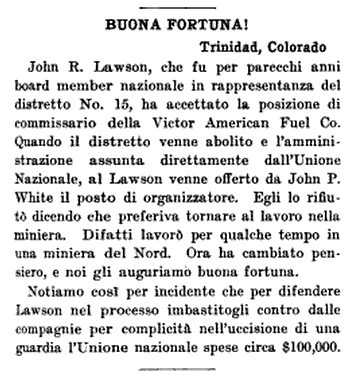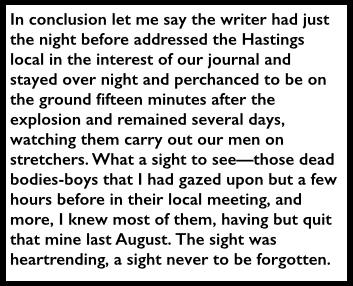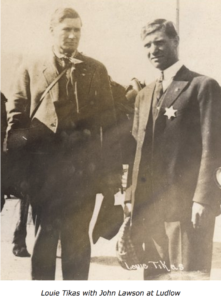Solemnly facing iron bars and prison walls,
I assert my love for justice
and my faith in its ultimate triumph.
-John R Lawson
Hellraisers Journal, Saturday June 9, 1917
From the United Mine Workers Journal: John Lawson Is Freed!
From the Journal of June 7, 1917:
Colorado Supreme Court Reverses
Lawson Judgment
Denver, Colo., June 4.—The Colorado supreme court today handed down a unanimous decision, all seven judges present and concurring, reversing judgments against John R. Lawson, who had been convicted by picked judge and jury in the Las Animas circuit court on the charge of first degree murder of a mine guard who fell in an attack upon the Ludlow tent colony, and against Louis Zancanelli, convicted in the court presided over by the same judge, Granby J. Hilliard, ex-coal operators’ attorney, on the charge of killing George Belcher, Baldwin-Feltz mine guard, on the streets of Trinidad, Colo.
The trials accorded these two miners have long been recognized by the decent lawyers and citizens of Colorado as a glaring intentional perversion of justice and a disgrace to the state. The decision rendered by the supreme court, reversing judgment, was based upon the fact that objection was entered by the defense against Judge Hilliard, recognized as an operators’ attorney, who had been appointed special judge by Governor Carlson to try, and convict, miners charged with crimes alleged to have been committed during the strike of 1913-14. After the trials of Lawson and Zancanelli, the supreme court handed down a decision prohibiting Judge Hilliard from trying any others of the strike cases.
The objection raised at the opening of the trial of John R. Lawson and Louis Zancanelli by lawyers for the defense—charging prejudice against Judge Hilliard and challenging his right to preside as judge, was considered sufficient cause for the reversal of judgment by the members of the supreme court. Other objections, equally as well founded, were not considered as the first objection was upheld. The defense had proof that the juries were selected from known enemies of the union miners, including several hired gunmen of the companies; that those of the jurymen who objected to rendering a verdict of guilty had been threatened with starvation, by order of the court, and one juryman in the Lawson case was told that his wife was dangerously ill, thus breaking down his opposition to the iniquitous verdict.
While the eases against John R. Lawson and Louis Zancanelli have been remanded back to Las Animas county for trial, there is little doubt but that the cases will be “nol-prossed” by the present district attorney at the first term of circuit court. Our persecuted brothers are practically free.
———-
[“Buona Fortuna” is from Italian language section of the Journal.]
The Journal on The Hastings Mine Disaster:
FROM COLORADO
The Hastings Explosion—Suposed Causes
Hastings, Colo., May 29.— I have been requested by the brothers of the Hastings local Union to write our paper regarding the sad explosion which took place here on Friday morning, April 27, at 9:20 o’clock.
At 7:30 a. m. 121 men entered the mine. The rope rider, commonly known as the trip rider, left the parting with his trip at 8:45 and remained on the bank top 15 minutes before he entered the mine with his empty trip. At a distance of 1,200 feet from the mouth of the slope he encountered a large volume of smoke oozing from the mine stopping. He ran the trip outside and gave the first alarm that the mine was either on fire or that some thing was wrong. Superintendent J. C. Cameron was just preparing to enter the mine when he received the report. Strange as it appears, no report was heard outside to indicate that anything had happened. The superintendent, with a half-dozen men, entered the mine, but could get no further than the intake of the air. Returning, he found his helmet men ready to enter at 10 o’clock. He returned with his helmet men and a score of others, who volunteered their services to enter the mine in search of their dying comrades.
The awful news having spread over the camp, men, women and children rushed to the mine, and at 10 o’clock mothers and children stood weeping and waiting to hear the news from their loved ones. A heavy snow began to fall and continued for several days. Still, those weeping mothers at home, waiting for news. It was not until 5 o’clock that word was sent on top that one body had been found dead.
The C, F. & I. [Rockefeller’s Colorado Fuel & Iron Company] sent the helmet men at once, as every indication pointed to the fact that there was no one alive. Coroner Bradley of Trinidad was soon on the scene, but it was not until the 29th that any bodies were brought to the surface. This continued until 101 bodies had been brought on top. The exploring crew found their work retarded by large falls of rock, and after going over the whole ground came to the conclusion that the remaining 20 bodies must be under the falls of rock, and at this writing no more bodies have been recovered. When 101 bodies had been recovered Coroner Bradley entered the mine, accompanied by the superintendent, to try and ascertain the cause of the accident. They concluded that the initial point of the explosion started at the seventh south entry, where Mine Inspector Reeves’ body was found. He held an inquest last Wednesday. The jurymen consisted of four miners and two other tradesmen.
The testimony given was to the effect that in the belief of the jury the explosion occurred on the seventh south entry by a naked light of the company mine inspector. To sum up the testimony briefly, E. P. Linsky, labor agent for the company, testified that there entered the mines that morning 121 men, of which 101 had been recovered, 93 identified and 8 unidentified. State Mine Inspector Dalrymple, Deputy Mine Inspector King, David Griffiths, general inspector for the Victor- American Fuel Company, together with J. C. Cameron, testified that the mine was well ventilated with several thousand cubic feet of air more than the law called for.
Minor testimony of the helmet men and other explorers was to the effect as to how they found the bodies, except the testimony of all regarding how they found Dave Reese, company mine inspector. The helmet man who first found Reese testified that he found Reese lying on his side, his head up against the rib, his safety lamp between his knees and the bottom of his safety lamp in his hands. Deputy Mine Inspector Graham and the coroner examined the body and the coroner found 22 matches in Reese’s pockets and the safety lamp apart. The seventh south being a gaseous part of the mine, the jury decided in their opinion he must have set the gas off when he took his lamp apart. The mine is lit up by electricity and miners use the electric lamp. No one is supposed to have a naked light, a pipe or any inflammable substance about them.
There was but one fatal accident amongst the explorers. Willis Kerr of Berwind, who led the helmet men, was overcome by the after damp and before aid was reached he died. In conclusion let me say the writer had just the night before addressed the Hastings local in the interest of our journal and stayed over night and perchanced to be on the ground fifteen minutes after the explosion and remained several days, watching them carry out our men on stretchers. What a sight to see—those dead bodies-boys that I had gazed upon but a few hours before in their local meeting, and more, I knew most of them, having but quit that mine last August. The sight was heartrending, a sight never to be forgotten.
T. B. McGregor.
———-
[Paragraph breaks and inset of quote added.]
The Journal on the Herrin Mine Disaster:
Nine Killed, Two Injured
in Illinois ExplosionHerrin, Ill., June 3.—An explosion of gas at the W. P. Rand mine, No. 2, near here, last night, resulted in the death of nine miners and very serious injury to two others.
From accounts at hand, the men were sent into an abandoned entry to remove track. The assistant mine manager removed a trap door, causing reversal of the air and resulting in driving a body of gas on the open lights of the men. It is said that the entry into which the men had been sent had not been examined by a competent fire-boss since last January.
The mine was not injured to any extent.
The names of the victims: Amos Mezo, Guy Vicery, Roy Weathers, Charles Rice, John Gossage, Ezra Adams, J. S. Good, Otis Reynolds and Ira Sanders, night boss. Severely injured: Thomas Cox, W. A. Brewer.
———-
SOURCE
The United Mine Workers Journal, Volume 28
(Indianapolis, Indiana)
-May 3, 1917 to Oct 25, 1917
(Sadly, many pages missing.)
Executive Board of the United Mine Workers of America
https://books.google.com/books?id=3wpOAAAAYAAJ
UMWJ June 7, 1917
https://play.google.com/books/reader?id=3wpOAAAAYAAJ&printsec=frontcover&pg=GBS.PT73
John Lawson & Colorado Supreme Court
https://play.google.com/books/reader?id=3wpOAAAAYAAJ&printsec=frontcover&pg=GBS.PT75
Hasting Mine Disaster
https://play.google.com/books/reader?id=3wpOAAAAYAAJ&printsec=frontcover&pg=GBS.PT79
Herrin Disaster
https://play.google.com/books/reader?id=3wpOAAAAYAAJ&printsec=frontcover&pg=GBS.PT80
IMAGES
John Lawson Free, Buona Fortuna, UMWJ p19, June 7, 1917
https://play.google.com/books/reader?id=3wpOAAAAYAAJ&printsec=frontcover&pg=GBS.PT88
John Lawson with Louie Tikas during the !913-14 strike.
https://ludlowsymposium.wordpress.com/about/
See also:
For more on John Lawson and Colorado Coalfield Strike of 1913-1914:
The Ludlow Massacre
by Walter H. FinK
Colorado, 1914
https://archive.org/stream/ludlowmassacrere00finkrich#page/n1/mode/2up
Hellraisers Journal: “Solemnly facing iron bars and prison walls, I assert my love for justice.” (The Lawson Statement-Lawson to Court before being sentenced to life in prison.)
http://www.dailykos.com/story/2015/7/14/1401566/-Hellraisers-Journal-Solemnly-facing-iron-bars-and-prison-walls-I-assert-my-love-for-justice
Hasting Mine Disaster of April 27, 1917
-with list of names.
http://usminedisasters.com/saxsewell/hastings.htm
Herrin Mine Disaster of June 2, 1917
http://usminedisasters.com/saxsewell/rend.htm
For more on John Lawson & Rescue Efforts at Hastings:
Out of the Depths
The Story of John R. Lawson a Labor Leader
-by Barron B. Beshoar
Colorado, 1980
Chapter XXVI: “Lawson Is Freed”, page 358
https://books.google.com/books?id=gQ4eAAAAIAAJ
[When he heard of the Hastings Mine Disaster,] Lawson, filled with horror, rushed [to the scene] to lend assistance. His offer of aid was welcomed and he was placed in charge of a rescue party. With Lawson leading the way, then men penetrated the mine to a depth of 7,000 feet. They found bodies, twisted and burned until they did not appear to be human.
“There isn’t a man left alive in there,” Lawson told James Dalrymple, chief mine inspector, when he came to the surface. “some are mutilated and some were just blown over like stems of wheat.”
Other crews brought bodies out and a carload of coffins was shipped from Denver. Lawson made the rounds of the camp, offering consolation to the survivors. There was the pretty, dark-eyed Austrian girl who stood forlornly by the side of a shack. She was to have been married to Steve Rockich within the week. Steve was dead. Jesus Herrera sobbed brokenly on Lawson’s shoulder. He had helped lift his 17-year-old brother, Fillipe, from under a half-ton rock.
All that day and all that night Lawson worked tirelessly, giving aid wherever he could. In the small hours of the morning, when the charred body of Tony Galavich was carried from the mine, screams came from the Galavich home. Mrs. Galavich, a widow now with eight children to support, was giving birth to a baby……
A Denver newspaper reporter, who was covering the story, wrote,
The biggest figure in Hastings today is John Lawson, the well-known labor leader and international character. Lawson has made the rounds of the little camp daily since coming here, offering what consolation he can to the stricken people in their hour of sorrow. Lawson is a man who, once met can never be forgotten. his name is on every tongue in Hastings…
[Photograph of Lawson and Martyr Louie Tikas added.]
Dedicated to John Lawson and Louie Tikas,
Heroes of the Colorado Coalfield Strike of 1913-14



